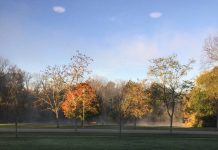A church that launched the small city of Columbus onto the national and international architectural scene 75 years ago fittingly will find itself at the heart of a fall design event expected to attract several thousand people.
And a new, temporary work, built next to the celebrated First Christian Church, will complement the structure of Finnish architect Eliel Saarinen. The title of the coming rebar and copper scale piece for what is called Exhibit Columbus is “Wiikiaami,” which means wigwam in the Miyaamia language.
Chris Cornelius of Studio:indigenous, the lead designer and a man of native American heritage, recently unveiled what he termed a modern wigwam for the First Christian site. In part, it is meant to represent Indiana’s native American heritage.
“I think there is a kind of latent spirituality in it,” said Cornelius, speaking by phone from his Milwaukee, Wisconsin, office. “The (Indian) culture of the people who were indigenous to the Columbus area is not that different from my (Indian) culture.”
[sc:text-divider text-divider-title=”Story continues below gallery” ]
Landmark Columbus’ new exhibition will premiere Aug. 26 at five downtown sites and stretch for about three months, according to organizers.
Five designers representing some of the nation’s top architects recently were named as the event’s Miller Prize winners. That means each winning team gets $70,000 to design and build a temporary architectural creation to complement one of those five downtown structures:
First Christian, 531 Fifth St.
Bartholomew County Public Library, 536 Fifth St.
Irwin Conference Center, 500 Washington St.
Cummins Inc. Corporate Office Building, 500 Jackson St.
Mill Race Park, Fifth and Lindsey streets.
This exhibition also will feature more than 10 installations by international designers, students and professors from Midwestern universities, and students from local schools.
“Really, this is a labor of love for all the designers,” said Richard McCoy, founder of Landmark Columbus and also Exhibit Columbus.
McCoy explained that the prize/project money is a modest sum for such an effort and for considerable construction, in some cases.
Funding for Exhibit Columbus, including the prize money, has come from individuals, foundations and corporations throughout Indiana. Exhibit Columbus is a project of Landmark Columbus, a program of Heritage Fund — The Community Foundation of Bartholomew County.
Landmark Columbus cares for the city’s artistic and architecturally significant sites.
Exhibit Columbus is part of an annual exploration of architecture, art, design and community. McCoy estimated last year that the exhibition premiere could draw 10,000 people over its fall run.
The late J. Irwin Miller, an executive with then-Cummins Engine Co., persuaded Saarinen, the son of a Lutheran pastor, to design First Christian. It was completed in 1942 as Tabernacle Church of Christ and became the city’s first Modern building — and the first structure by a nationally or internationally known designer.
Larry Ruble, First Christian’s archivist, said he already likes Cornelius’ work.
“I especially like the fact that it will be built for people to actually walk through and maybe pause in for a while,” Ruble said.
Ruble also is impressed that Cornelius will position his piece for the natural sunlight to best highlight it, just as Saarinen did with First Christian’s windows.
“And I like the fact that he will tuck it back in the trees in that natural setting,” Ruble said. “It’s not ostentatious. And I like the fact that this (wigwam) and church campanile both point to the heavens.”
Cornelius did enough research on First Christian to realize that its design was deemed slightly unusual for the time period.
“People had very distinct thoughts in the late 1930s and early 1940s about what a church should be,” Cornelius said. “And at that time, this wasn’t exactly what some people had pictured for a place of worship.
“And I am trying to create something that is current and contemporary that might spur people to want to know more about architecture and more about spirituality.”
[sc:pullout-title pullout-title=”Exhibits that will last?” ][sc:pullout-text-begin]
When the exhibition phase of Exhibit Columbus was announced last year, organizers originally referred to architects’ creations as temporary around the city.
And they will be temporary in Columbus.
But Richard McCoy, who launched the Landmark Columbus parent organization and also Exhibit Columbus, reports now that at least some of the five main works from Miller Prize winners probably will live on somewhere.
He confirmed that he already has been in contact with sources who want to make a spot for one of the works, but cannot discuss details until later.
“We will probably find homes,” McCoy said.
[sc:pullout-text-end]




